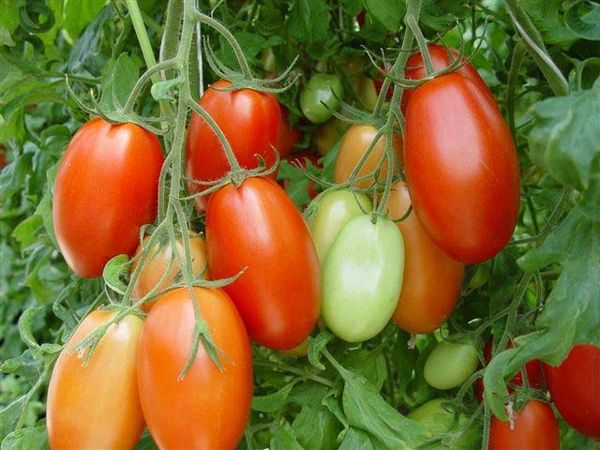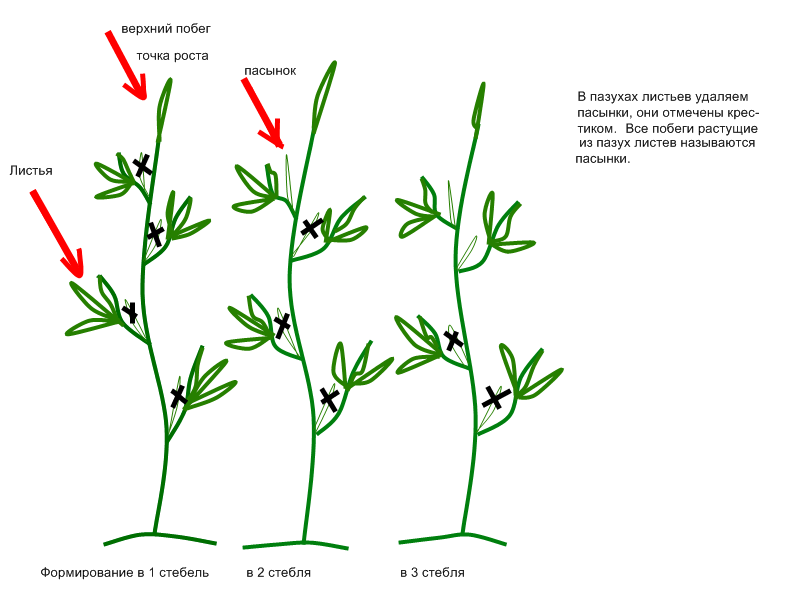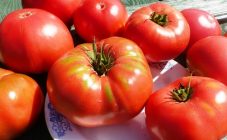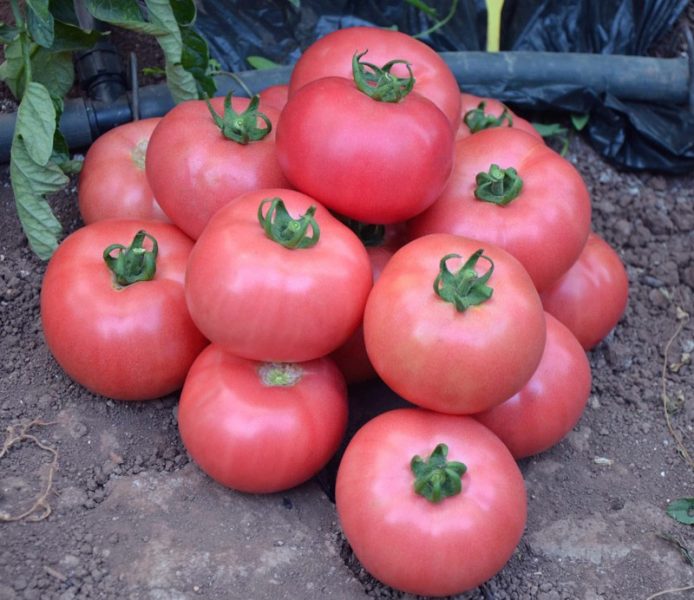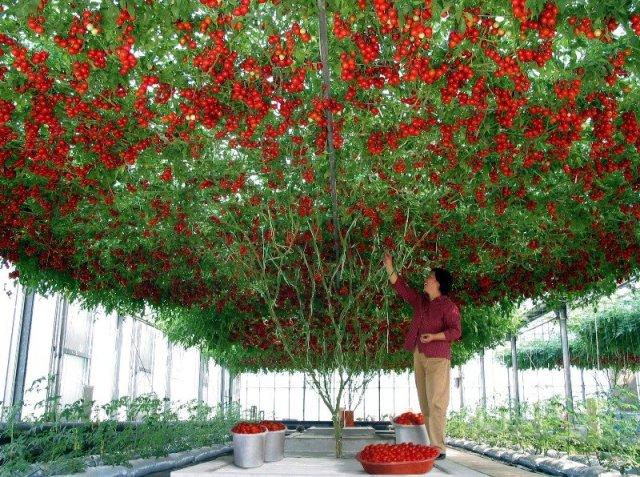Content:
Tomatoes are considered the most popular vegetable crop grown in summer cottages throughout the country. In areas with cold climatic conditions, determinant (low-growing) varieties of tomatoes are most often grown - due to the limited growth of the bushes, the fruits ripen faster, and the crop does not have to be ripened in boxes.
The best varieties of low-growing tomatoes for greenhouses and open ground
In our time, many varieties and hybrids of tomatoes have been bred, characterized by low growth of bushes, but at the same time maintaining a high yield. Depending on the region of cultivation, the most productive varieties and hybrids of the crop can be distinguished.
Low-growing tomatoes. The best varieties for the Moscow region and the southern part of the Chernozem region (Middle lane)
For this climatic zone of the country, the best are tomatoes that are resistant to temperature extremes and common diseases, and are unpretentious to care for. They are mostly grown outdoors, but most of the bush tomatoes below can also be planted in a greenhouse.
- Brawler yellow. A plant that does not exceed 50 cm in height (when grown outdoors) begins to bear fruit 100 days after sprouting. The fruits are medium-sized (some can reach 120 g, the main amount is about 70 g), sweet, slightly sour, fleshy and juicy, they contain very few seeds. The color is bright yellow, the shape is elongated, plum-shaped. Productivity - 25 kg / m2.
- Watercolor. Small (weighing 40-55 g, some can grow up to 120 g) egg-shaped fruits of this variety are characterized by dense skin and pulp, good taste and aroma. The bush is low, does not grow more than half a meter. Tomatoes can be harvested 110 days after germination. The maximum yield is 8 kg / m2.
- El Dorado. Mid-season variety, so tomatoes can be harvested no earlier than 110 days after germination. It belongs to low-growing varieties of tomatoes, but requires support, since its height reaches 90 cm. The bush forms heart-shaped orange-yellow fruits weighing up to 400 g. The pulp is very tasty, dense. The maximum yield is 9 kg / m2.
- Roma. The variety, in terms of ripening, belongs to the mid-season (from the moment the first shoots appear to harvest, it takes 105-120 days). The height of the bush is 35-60 cm, depending on the place of planting. Red plum fruits have a dense fleshy pulp of good taste and an average weight of 60-80 g. Productivity - 12-15 kg / m2.
- Rocket. Mid-late ripening (115-130 days after seed germination) allows you to extend the season of low-growing tomatoes. The fruits are medium-sized - 40-60 g, while the bushes (in the open field they grow up to 40 cm, and in the protected field - up to 60 cm) are very productive - up to 7 kg of elongated plum tomatoes with good taste can be harvested from one plant.
- Abakan pink. In open ground, the height of the bush will be no more than 70 cm. It is characterized by a long fruiting period, and the first tomatoes of this variety can be harvested 110 ... 120 days after seed germination. The average size of ripe fruits is 250-300 g.If desired, you can get larger fruits weighing up to 800 g, but their number will be less. The shape of the tomatoes is heart-shaped, pink in color. The taste is excellent, sweet. The pulp is fleshy, juicy. The average yield of the variety is 4.5 kg / bush.
- Titanium. Bushes no more than half a meter in height give small (120 g) fruits with excellent marketable and taste characteristics. Titanium belongs to the mid-late tomatoes, as it ripens 135 days after germination. The maximum yield for office maintenance is 4.5 kg / bush.
The best low-growing varieties of open and protected ground for the Urals
The climate of the Urals is quite unpredictable, therefore it is recommended to grow low-growing early varieties of tomatoes that are resistant to diseases and stress situations in this region.
Below are the most productive hybrids of low early ripening tomatoes of the Ural selection.
- Snowman. Fruits with an average weight of up to 160 g ripen early - 80-85 days after the emergence of sprouts. Tomatoes are tasty, juicy, have a thin skin and do not crack. When grown outdoors, the height of the bush can reach 70 cm, and the yield is 9 kg / m2. In protected ground conditions, the Snowman grows up to 120 cm, and its yield also increases to 15 kg / m2.
- Juggler. Plants of this hybrid are bushy, in the open field do not exceed 60 cm, in a greenhouse - 1 m. Rounded tomatoes weighing up to 250 g ripen 90-95 days after germination. Smooth, strong fruits are distinguished by high taste.
- Katrina. Ripening period is only 85 days after sprouting. When planted in open ground, the height of the bush will be 60 cm, and in a greenhouse - 100-120. Rounded fruits of bright red color have excellent taste characteristics, a pronounced tomato aroma and a decent weight - 150-200 g. The yield is high - 5 kg / bush.
- Super prize. Small fruits weighing 140-150 g ripen after 85 days, are characterized by juicy, aromatic pulp and flat-rounded shape. From 1 m2, 8-9 kg of tomatoes can be harvested when planted in open ground, in a protected area, the figure is higher - 10-12 kg.
- Zenith. Ripens in 95-100 days after germination. Average weight of fruits - 100-105 g, ripe tomatoes are colored bright red, have an even rounded shape. The bushes are low - 70-120 cm, depending on the place of planting. The maximum yield is 10 kg / m2.
The best yielding varieties for Siberia, grown in the open field and in the greenhouse
Dwarf tomatoes of Siberian selection are distinguished by increased cold resistance, resistance to temperature extremes, early ripening and a friendly return of the harvest. If you add a high yield to the above advantages, then you can select several of the most worthy undersized varieties.
- Heavyweight of Siberia. The plant is not tall, does not exceed 70 cm in the open field and 1 m in the greenhouse. The average weight of the fruits of this variety is 400-500 g. When using some agricultural techniques, you can get tomatoes weighing up to 900 g. Heart-shaped, pink-scarlet color. Taste characteristics of the fruits are excellent: the pulp is sweet, juicy, fleshy. An amazing feature of the Heavyweight of Siberia is the combination of early ripening (95-105 days after germination) and large-fruited.
- Wind rose. It is characterized by early ripening (95-97 days after sprouting). A squat bush no more than 50 cm in height gives medium-sized rounded pink fruits, which are distinguished by good keeping rates and transportability.
- White filling. One of the oldest varieties of early Siberian tomatoes - the fruits ripen in 95-100 days after the appearance of young shoots. The height of the bush in the greenhouse is up to 70 cm, and even less in open ground - 50 cm. The weight of the fruit is 80-130 g, the taste is excellent, with a pleasant tomato aroma, and the marketable qualities are high.
- Ultra-ripe. The name of the tomato speaks for itself - the crop ripens quickly, within 1.5 months after the emergence of sprouts. The maximum height of the bush is 50 cm. The weight of the fruit is no more than 100 g, perfect for canning.
- The Velvet season. In terms of ripening, it belongs to the medium early (fruits are removed 110 days after germination). The growth of the bush is limited and, depending on the planting site (open ground or greenhouse), can reach a height of 50 to 80 cm. Bright red fruits are round in shape and an average weight of at least 300 g, the flesh is fleshy, sugary.
- Ballerina. The size of the bush does not exceed 60 cm. Pepper tomatoes ripen in 100-105 days from the moment the seeds germinate. The mass of one fruit is about 150 g. The taste is excellent.
- Nastenka. Medium early in terms of ripening, a relatively new variety, the harvest of which is harvested in 95-105 days from the moment of emergence. The height of the bush is no more than 70 cm. Fruits are pink-scarlet, round, medium-sized (up to 200 g). The pulp is fleshy with a pronounced tomato flavor.
- Alsou. Depending on the place of planting of this variety, the height of the bush can vary: 80 cm - in the open, about 1 m - in protected ground. The variety belongs to large-fruited, the weight of the fruit can reach 800 g (individual specimens).
- Demidov. A mid-early variety (fruits are harvested 100-110 days after germination) characterized by small rounded fruits weighing up to 120 g. Their taste is excellent, long-term storage of the crop. The maximum height of the bush is 65 cm.
Features of growing undersized tomatoes
The agricultural technology for growing dwarf tomatoes is somewhat different from the standard technology.
Sowing seeds
Determinant tomatoes are sown later on seedlings than tall ones. The approximate sowing time is the beginning of March. Seedlings are planted in open ground, which are about 60 days old, and younger bushes 45 days old can be planted in the greenhouse. In warm regions of the country, sowing seeds of early ripening bush tomatoes can be carried out directly into the ground.
Disembarkation to a permanent place
Most low-growing varieties of tomatoes are characterized by spreading bushes, therefore, in this case, a sparse planting scheme is recommended. You can plant 4-7 seedlings per 1 m2. If the determinant variety is grown in one stem, and the branching of the bush is weak, then the planting can be compacted and 10-12 tomato roots per 1 m2 can be planted.
Care
Most determinant tomatoes are undemanding to care for, but in order to get the maximum yield from them, it is necessary to periodically perform some operations.
- Watering. After planting the seedlings in a permanent place, it is recommended to keep the soil moist for a week. Like all other tomatoes, stunted plants do not like frequent and abundant watering. Under the bushes, it is enough to add no more than 5 liters of water every 4-5 days. If the weather is hot for several days, the amount of watering can be increased up to 2 times a week.
- Garter. Many determinant varieties of open ground do not need tying and organizing supports. In a greenhouse, the height of tomatoes is always higher than in the open air, so you still have to tie them up. In protected ground conditions, tying up the bushes will provide good uniform illumination of the plantings and air permeability. Tomatoes for open ground can also be tied up so that the plants do not break under strong winds or under the weight of their own fruits.
- Formation. Determinant tomatoes differ from other varieties of culture in their simplicity in formation. But to get an early harvest, it is still recommended to form them.
- Stealing. Almost all of the above varieties do not need pinching. You can grow bushes in two or three stems, pinch the rest of the shoots.
Important! For the formation of the main stems, you can leave strong stepsons coming from the axils of the lower leaves. The processes of the lower part of the stem are not suitable for these purposes, they must be removed. If the tomatoes are not pinched, then you can simply shorten the branches when the plant stops growing. When pinching branches, it is necessary to leave 2-3 leaves above the extreme ovary.
- Control of the number of ovaries. In order to obtain large fruits, it is necessary to leave fewer ovaries, blinding the extra ones.
- Thinning of green mass. It is imperative to remove the lower leaves of the tomatoes. Thinning of foliage begins when the tomatoes of the first cluster ripen. Once a week, 1-2 sheets should be torn off. Thus, by the time the second brush ripens, all leaf plates under it will be removed. Do not remove more than two leaf blades in one go, otherwise the tomatoes are stressed.
- Top dressing. Just like other types of tomatoes, determinants need timely nutrient intake. The feeding scheme is standard, but the consumption of the working solution per bush can be less.
Diseases and pests of undersized tomatoes
Diseases of stunted tomatoes are characteristic of the same as other representatives of this culture. But the early early-ripening varieties are practically not affected by such a common disease as late blight - they simply do not have time to become infected with it, since their fruiting ends quickly. Disease prevention refers to adherence to the recommended planting pattern and proper care throughout the season. The above best tomato varieties are resistant to a whole range of possible diseases.
The most common pests of tomatoes include bear, wireworm, caterpillars, snails. In specialized stores there is a large selection of products to combat these pests.

